Lava Xolo X900 Review - The First Intel Medfield Phone
by Brian Klug on April 25, 2012 6:00 AM ESTFor Intel, the road to their first real competitive smartphone SoC has been a long one. Shortly after joining AnandTech and beginning this journey writing about both smartphones and the SoC space, I remember hopping on a call with Anand and some Intel folks to talk about Moorestown. While we never did see Moorestown in a smartphone, we did see it in a few tablets, and even looked at performance in an OpenPeak Tablet at IDF 2011. Back then performance was more than competitive against the single core Cortex A8s in a number of other devices, but power profile, lack of ISP, video encode, decode, or PoP LPDDR2 support, and the number of discrete packages required to implement Moorestown, made it impossible to build a smartphone around. While Moorestown was never the success that Intel was hoping for, it paved the way for something that finally brings x86 both down to a place on the power-performance curve that until now has been dominated by ARM-powered SoCs, and includes all the things hanging off the edges that you need (ISP, encode, decode, integrated memory controller, etc), and it’s called Medfield. With Medfield, Intel finally has a real, bona fide SoC that is already in a number of devices shipping before the end of 2012.
In both an attempt to prove that its Medfield platform is competitive enough to ship in actual smartphones, and speed up the process of getting the platform to market, Intel created its own smartphone Form Factor Reference Design (FFRD). While the act of making a reference device is wholly unsurprising since it’s analogous to Qualcomm’s MSM MDPs or even TI’s OMAP Blaze MDP, what is surprising is its polish and aim. We’ve seen and talked about the FFRD a number of times before, including our first glimpse at IDF 2011 and numerous times since then. Led by Mike Bell (of Apple and Palm, formerly), a team at Intel with the mandate of making a smartphone around Medfield created a highly polished device as both a demonstration platform for OEM customers and for sale directly to the customer through participating carriers. This FFRD has served as the basis for the first Medfield smartphones that will (and already are) shipping this year, including the Orange Santa Clara, Lenovo K800, and the device we’re looking at today, the Lava Xolo X900. Future Medfield-based devices will deviate from the FFRD design (like the upcoming Motorola device), but will still be based loosely on the whole Medfield platform. For now, in the form of the X900 we’re basically looking at the FFRD with almost no adulteration from carriers or other OEMs.
The purpose and scope of this review is ambitious and really covers two things - both an overview of Intel’s Medfield platform built around the Atom Z2460 Penwell SoC, and a review of the Xolo X900 smartphone FFRD derivative itself.
The Device
Beginning April 23rd, Intel, through Lava International, began selling the Xolo X900 smartphone in India for INR 22000 (~$420 USD). As we’ve stated before, the design and construction of the Xolo X900 almost identically mirrors the Intel FFRD we’ve seen before, from the specifications and Medfield platform itself, to industrial design and exterior buttons.
It’s a testament to the polish of the reference design that Mike Bell’s team put together that Intel is confident enough to basically sell exactly that device through carrier partners. I’ll admit I was skeptical upon hearing that Intel would basically be selling their MDP to customers, but the device’s fit and polish exceeded my expectations and are clearly those of something ready for customer abuse. First up are the X900 specifications in our regular table (below), Xolo also has its own nicely presented specifications page for the X900 online.
| Physical Comparison | ||||
| Apple iPhone 4S | Samsung Galaxy S 2 | Samsung Galaxy Nexus (GSM/UMTS) | Lava Xolo X900 | |
| Height | 115.2 mm (4.5") | 125.3 mm (4.93") | 135.5 mm (5.33") | 123 mm (4.84") |
| Width | 58.6 mm (2.31") | 66.1 mm (2.60") | 67.94 mm (2.67) | 63 mm (2.48") |
| Depth | 9.3 mm ( 0.37") | 8.49 mm (0.33") | 8.94 mm (0.35") | 10.99 mm (0.43") |
| Weight | 140 g (4.9 oz) | 115 g (4.06 oz) | 135 g (4.8 oz) | 127 g (4.5 oz) |
| CPU | Apple A5 @ ~800MHz Dual Core Cortex A9 | 1.2 GHz Exynos 4210 Dual Core Cortex A9 | 1.2 GHz Dual Core Cortex-A9 OMAP 4460 | 1.6 GHz Intel Atom Z2460 with HT (1C2T) |
| GPU | PowerVR SGX 543MP2 | ARM Mali-400 | PowerVR SGX 540 @ 304 MHz | PowerVR SGX 540 @ 400 MHz |
| RAM | 512MB LPDDR2-800 | 1 GB LPDDR2 | 1 GB LPDDR2 | 1 GB LPDDR2 @ 400 MHz |
| NAND | 16GB, 32GB or 64GB integrated | 16 GB NAND with up to 32 GB microSD | 16/32 GB NAND | 16 GB NAND |
| Camera | 8 MP with LED Flash + Front Facing Camera | 8 MP AF/LED flash, 2 MP front facing | 5 MP with AF/LED Flash, 1080p30 video recording, 1.3 MP front facing | 8 MP with AF/LED Flash, 1080p30 video recording, 1.3 MP front facing |
| Screen | 3.5" 640 x 960 LED backlit LCD | 4.27" 800 x 480 SAMOLED+ | 4.65" 1280x720 SAMOLED HD | 4.03" 1024x600 LED backlit LCD |
| Battery | Internal 5.3 Whr | Removable 6.11 Whr | Removable 6.48 Whr | Internal 5.4 Whr |
It’s interesting to me that Intel, Qualcomm, and others identified and went with WSVGA (1024x600) for their reference designs in roughly the same 4" size. It’s a display form factor that corresponds almost exactly to 300 PPI, and looks great, but more on that later. The rest of the X900 is basically what you’d expect for a smartphone of this generation, and on par with the Android competition that Intel was targeting, perhaps minus microSD expansion.
The design language of the X900 (and Intel FFRD) is a pretty obvious nod to the iPhone 4/4S design, complete with chrome ring, similar button placement, and a few other things. Likewise, the X900 uses a microSIM whose tray is located on the right side and makes use of an ejector port and tool. Below that is the X900’s two-stage camera button, and then speaker port. There’s a matching speaker port on the other side in the same area.
MicroUSB is located at the very bottom slightly off center, and microHDMI is on the left side. Up at the top is power/standby and the standard headphone jack. There’s no real surprises here, and despite being entirely plastic-clad, the X900 feels pretty decent in the hand.
The backside is a soft touch material which we’ve seen and felt on countless other smartphones before. The only downside to the X900 design is lack of a user replaceable battery - the backside is permanently attached. At the top is the 8 MP camera port, adjacent LED flash, and secondary microphone for noise suppression.
The front of the X900 is likewise pretty standard fare - up top are the 1.3 MP front facing camera, speaker grille, ambient light sensor, and proximity sensor. At the bottom are the four Android capacitive buttons whose design mirrors the FFRD we’ve seen before.
Again there’s nothing super crazy about the design or construction of the X900, it’s an extremely polished reference design turned consumer electronic that feels solid and ready for use as a daily driver if you’re up for it. Enough about the superficial stuff though, let’s talk about what everyone wants to know about - Medfield and Android on x86.


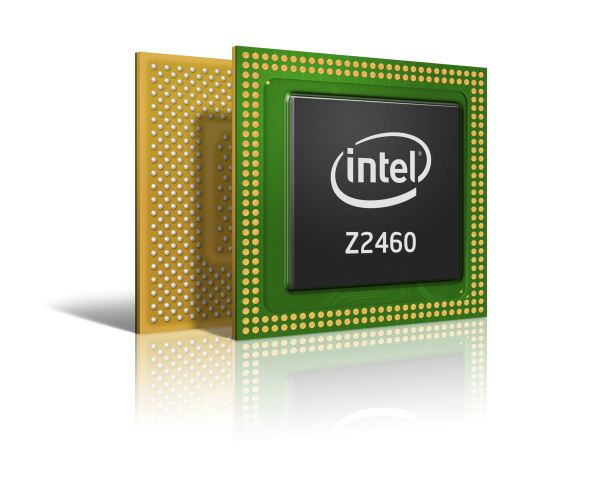
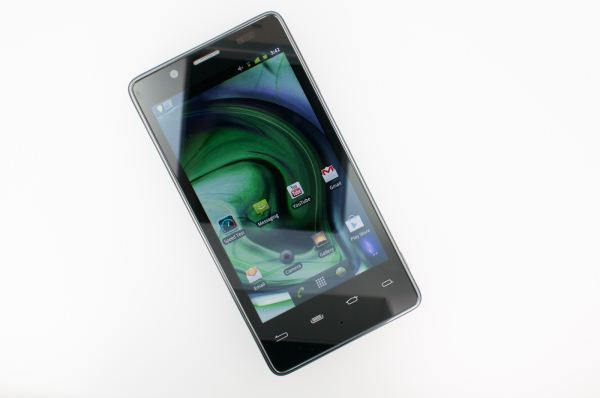
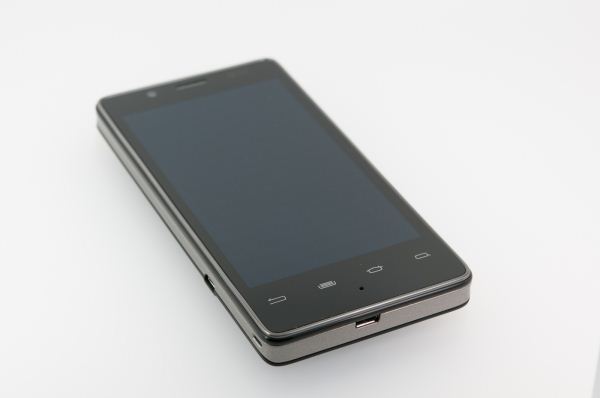
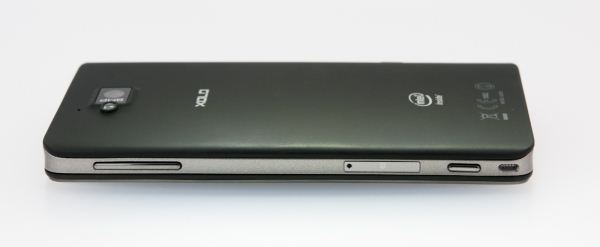
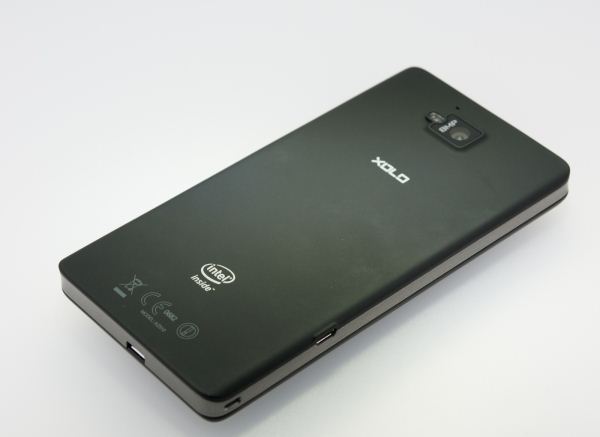
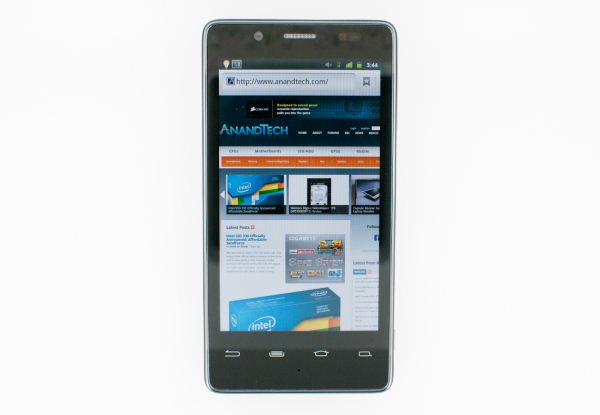














106 Comments
View All Comments
Spunjji - Thursday, April 26, 2012 - link
...so, suddenly it becomes more than mere opinion when you say the opposite? You have to admit you're on shaky ground with that line of argument."Could benefit from being thinner" isn't quite the same as "too thick". I suspect you mean the former?
UltraTech79 - Thursday, April 26, 2012 - link
Its not an opinion when its true. Phones should stay below 1CM thickness, and even 1CM is pretty beefy. Many people will not consider it due to this and not having a real huge advantage anywhere else.When all else is roughly the same, comfort and aesthetics decide a buy.
phoenix_rizzen - Friday, April 27, 2012 - link
1 cm is *way* too thin for anyone with "normal"-sized hands.Compare the aesthetics of holding/using a cordless phone, an office phone, a corded-phone, basically any phone handset other than a cell phone to a cell phone. Which feels more comfortable in your hand to speak into for more than 3 seconds? The one that fits nicely in the palm of your hand, that nicely curves with the natural lines of your hand (aka everything other than a cell)? Or the one with sharp edges, barely 1 cm thick, that requires you to use the muscles in the sides of your hands to grip, leading to cramping if you actually try to, you know, talk, on the phone?
Today's cell phones are too thin, and battery life is suffering for it.
fm123 - Friday, April 27, 2012 - link
Definitely an opinion. If someone wants a keyboard it's going to be over 1 cm. There are people that put their phone in cases and the result is way over 1 cm. The Otterbox Defender is somewhat popular, and the phone becomes almost 3/4 inch thick.FrederickL - Thursday, April 26, 2012 - link
On the general issue of "phone-thinness" rather than this phone in particular no doubt the same people who want the mobile equivalent of an anorexic catwalk model will then start howling about the battery life in their super-thin phone where there is scarcely room for a battery at all, let alone one with decent capacity. Perhaps we should be discussing the fact that some customers' contradictory "want my cake and eat it" demands indicate that the topic should be that some of the customers are too thick rather than the phones.
mrtanner70 - Wednesday, April 25, 2012 - link
I find the "a bigger battery is all we need" argument rather weird in the context of the thickness. It's not like Intel has not already considered this trade off. It's lighter than I expected though.The trouble with reviews like this (and this is not a criticism) is that SOC price is not considered, nor that fact that the mobile industry really would rather Intel, and its monopolistic/margin desires, stay away. Benchmarks (unless paradigm breaking) are not going to change that.
So far, I do not believe Intel has a single true design win, they paid for them all.
menting - Wednesday, April 25, 2012 - link
profit margins for ARM and Intel as a whole company, if this page can be believed, are similarhttp://ycharts.com/companies/ARMH/profit_margin#se...
menting - Wednesday, April 25, 2012 - link
we dont know what that phone will cost in the US, but for a phone that costs $420 with that performance???? ARM will be pissing in their pants right now if it had the performance of A15 on that phone.duploxxx - Wednesday, April 25, 2012 - link
Knowing that it can't keep up against already existing platforms introduced a while ago it is a failure. Don't see any reason why to buy this mobile phone, it doesn't have any added value against any other major competitor.not on price/power/performance.
so it is doomed before it is even released.
lets see what the tablet brings, but it doesn't look good at all. It all starts with the Atom which has never proven to be a good arch.....
A5 - Wednesday, April 25, 2012 - link
For a first attempt (Moorestown was always going to fail, so I don't count it :P) it really isn't that bad. It pretty handily beats the A9-class SoCs from last year while being somewhat competitive with the S4 running ICS. I'm curious to see if the Medfield ICS build gets better performance.I don't know how much Medfield phones will cost, but if it comes over here as a $420 off-contract device, that places it pretty firmly in the mid-range, where it would certainly be pretty competitive with the A9 devices that will be down there.